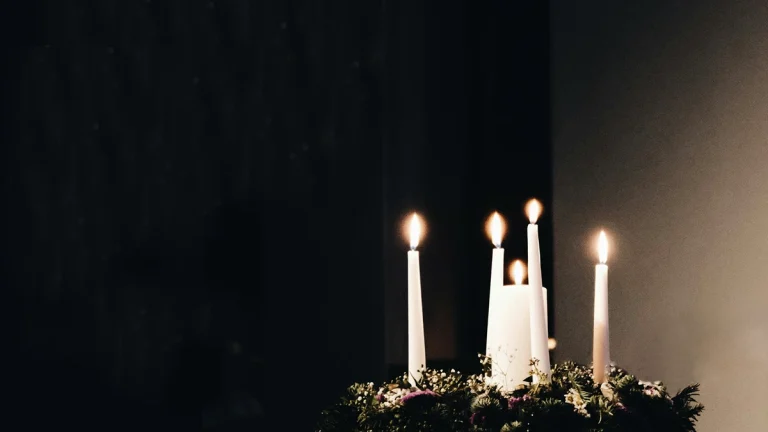A few years ago, the women’s ministry at my Presbyterian church spent the weekend at a Catholic prayer retreat. The days were full of reflection and prayer, and I spent an afternoon wandering the woodland gardens. It was here that I discovered the Stations of the Cross for the first time.
Each station consisted of a large rock with a metal sign depicting part of the Crucifixion story, such as Pilate condemning Jesus or Jesus nailed to the cross. The stones were placed near a bubbling stream, deep within a canopy of oaks and maples, and I initially expected a beautiful hike through nature and nothing else. But as I moved forward, the physical markers made the cross – and the whole gospel story – resonate with me.
Like other practices of incarnational worship, including prayer labyrinths and Advent wreaths, the Stations of the Cross helps make our faith tangible. They constitute a bulwark against gnosticism and distraction, reminding us that in Jesus we follow a God who became flesh (John 1:14), a God whom we must love with our physical body as well as with our heart, our spirit , and the soul (Mark 12:30). And they also remind us of God’s work in and through us and of the generations of Christians before us who developed and preserved these legendary practices.
Scripture is loaded with calls to remembrance. “Remember his wonderful works that he has done,” says Psalm 105, while 1 Corinthians 11:24 tells us to practice communion “in remembrance of me.” The Stations of the Cross gives us space to reflect on what is always worth remembering: that we are saved by the grace of God through the sacrifice of Christ, and that God is not finished with his physical creation but remains active among us, working to redeem and renew the world.
The unhurried physicality of this practice was a boon to my prayer life that afternoon – the Stations are meant to be walked in a slow, meditative manner – and as I wandered, I I found that my prayers became more focused and less abstract. Prayer mazes are designed for a similar effect.
Mazes look like circular mazes, but they are completed in two phases. First, we seek the center, physically bringing prayers, supplications, and questions to God. Then, having reached the center, we return to the edge of the labyrinth, preparing to return to the world renewed for God’s service, refocused on the Gospel and drawn from our distraction-prone minds and emotionally overloaded hearts for a truer communion with Christ. .
Stations and mazes don’t ignore our tired bodies, as we can tend to do. Instead, step by step, they bring us closer to God—not despite our tired legs, broken hearts, and sweaty palms, but because of them.
Although commonly associated with Catholicism today, both practices are raw has have their roots in the pilgrimages of the first Christians, who retraced the steps of Jesus as he approached the cross. Stations and labyrinths provided a local alternative to difficult, dangerous, and expensive pilgrimages, allowing Christians in the early Church and the Middle Ages to experience an embodied journey of prayer and remembrance on an accessible scale.
The basic concept of a maze is even older, dating from Ancient Greek story of Theseus and the Minotaur. Christians reused the idea, first use a devotional labyrinth in an Algerian church in the 4th century. In addition to serving as a miniature pilgrimage, the first labyrinths also represented the twists and turns of the Christian journey. They became increasingly popular in early medieval churches during the 9th and 10th centuries, spreading across the European continent during the second millennium of the Church.
And prayer labyrinths are not the only physical marker of the Gospel with roots in a pagan context. The Advent wreath also comes from ancient Greco-Roman culture – where wreaths of laurel and olive branches were worn as crowns to symbolize greatness and wealth – and the Germanic tribes of early medieval Europe, who used evergreen wreaths to symbolize the hope of spring.
The church found new and better uses for these wreaths. Their evergreen fronds symbolized both eternal life through Christ and the eternal nature of God. The red berries and thorny leaves of the holly trees recalled the blood of Jesus and his painful crown of thorns.
However less old Tradition, Advent candles encourage meditation and remembrance, as does the patient and progressive Stations of the Cross. Often placed on or near the Advent wreath and lit slowly in the weeks leading up to Christmas, candles remind us of the “already but not yet” tension that is so dear to our faith. We rejoice as we get closer to Advent, but we are acutely aware of the pain and sorrow that fill this world, and we remember with hope that Jesus will return.
The Gospel is a wonderful picture of redemption. But we become easily distracted, forgetting the wonder of the stories, verses, and sermons we know so well. These physical reminders of our faith can bring us back to attention, creating space for reflection and embodiment, allowing us to grasp anew the beauty of the Gospel, step by step, turn by turn, candle by candle.
Rabekah Henderson is a writer covering faith, architecture, and the built world around us. She lives in Raleigh, North Carolina, and has been featured in Simple orthodoxy, Common goodAnd Remain.


